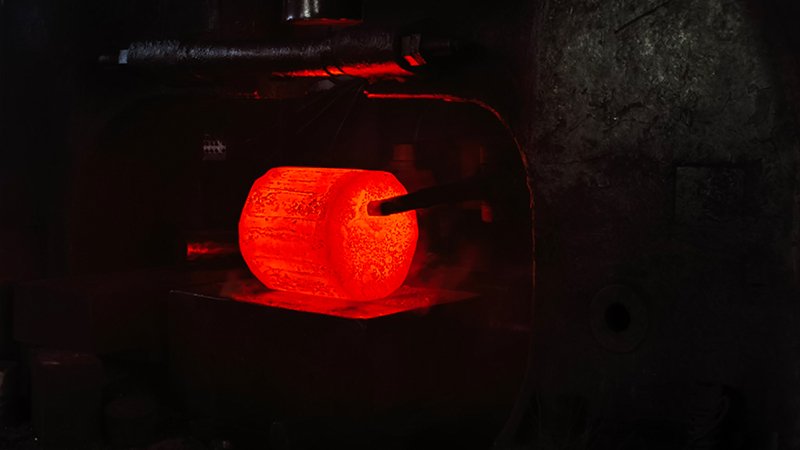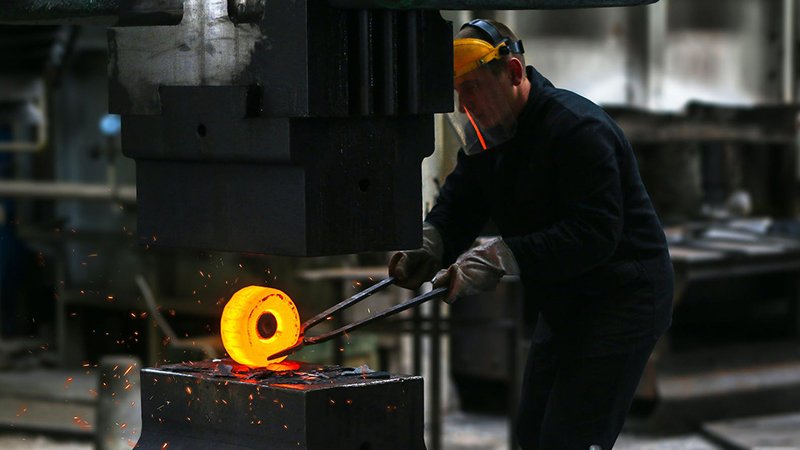Welcome to Sinostar Industrial Machinery Co., Ltd.
Forging is divided into free end and die forging. This article focuses on free forging.
Sinostar MACH's free forging equipment can complete metal processing parts from 1KG to 5Ton. The free forging production process has a relatively large impact on the surrounding environment. Therefore, our environmental protection and shock absorption work is done very well.
Next, let's introduce the process and characteristics of free forging.
Open die forging, also known as free forging, is a metal shaping process where the workpiece is hammered or pressed between two flat dies, without any confinement.
It differs from closed die forging, where the workpiece is completely enclosed within dies.

Definition and overview
Open die forging is a metalworking process that involves shaping a metal workpiece between two dies without enclosing the material. This process is widely used in manufacturing industries to produce high-quality, durable metal components.
Comparison with closed die forging
First, open die forging is a process where the metal is shaped by repeatedly striking it with a hammer or a press. The metal isn’t confined within a die, allowing for greater freedom in shaping complex parts.
On the other hand, closed die forging involves placing the metal between two dies and applying immense pressure to shape it. This process is ideal for creating intricate and precise parts.
Open die forging offers advantages such as improved mechanical properties, reduction in material waste, and cost-effectiveness.
Closed die forging, on the other hand, is suitable for applications that require high precision and tight tolerances.

Advantages and limitations of open die forging
Open die forging offers several advantages. It has the ability to produce large and complex shapes, which is beneficial for industries that require customized components and parts. Furthermore, open die forging results in improved mechanical properties due to grain refinement. This means that the final product will have enhanced strength and toughness. Another advantage is that open die forging provides enhanced structural integrity, making it suitable for applications where strength and reliability are crucial.
However, open die forging also has its limitations. One limitation is that it requires skilled operators and specialized equipment. This means that the process can be costly, as it requires trained personnel and specific tools to carry out the forging operation. Additionally, open die forging is not suitable for high precision and intricate designs. This is because the process may result in lower dimensional accuracy and surface finish. Therefore, industries that require precise and detailed components may need to consider other manufacturing methods.
Advantages
The advantages of open die forging have numerous benefits in terms of flexibility and cost-effectiveness:
● Versatility: Open die forging allows for the production of a wide range of shapes and sizes, making it suitable for various applications.
● Improved grain structure: The process of open die forging enhances the metallurgical properties of the material, resulting in improved strength, toughness, and resistance to fatigue.
● Cost-effectiveness: Open die forging is a cost-effective manufacturing method, as it requires minimal tooling and allows for the use of lower-cost ingots or billets.
● Customization: Open die forging offers flexibility in terms of material selection, allowing manufacturers to choose the most suitable alloy for specific applications.

Limitations
One limitation is the lack of precise control over the final product’s shape and dimensions, as the process relies on manual manipulation and repeated heating and cooling.
Additionally, open die forging may result in increased material waste due to the need for excess stock to accommodate the forging process.
Furthermore, the process can be time-consuming and labor-intensive, leading to higher production costs.
Therefore, when considering open die forging, it’s important to carefully evaluate the limitations and assess the impact on the final product’s quality and cost considerations.
Materials used in open die forging
Open die forging commonly used materials include carbon steel, alloy steel, stainless steel, and titanium. However, the selection of the material depends on various factors such as the desired mechanical properties, the intended application, and the feasibility of forging the material.
Considerations for material selection may include factors like strength, ductility, machinability, and heat resistance, ensuring that the chosen material is well-suited for the specific forging process and the final product requirements.
One of the most commonly used materials in open die forging is steel. Steel is preferred for its excellent strength, durability, and ability to withstand high temperatures.
● Aluminum: Known for its lightweight and corrosion resistance, aluminum is often used in industries such as aerospace and automotive.
● Titanium: With its high strength-to-weight ratio and exceptional corrosion resistance, titanium is commonly used in the aerospace and medical industries.
● Copper: Known for its excellent thermal and electrical conductivity, copper is often used in electrical components and heat exchangers.
● Nickel-based alloys: These alloys offer excellent resistance to high temperatures, corrosion, and wear, making them suitable for applications in the oil and gas, chemical, and power generation.

Industries and products
Open die forging is utilized by a wide range of industries due to its versatility and ability to create complex shapes. This process is commonly employed in industries such as aerospace, automotive, oil and gas, and power generation.
Examples of products that can be made through open die forging include crankshafts, connecting rods, turbine shafts, and gears. The flexibility and strength of open die forging make it a preferred method for producing components that require high reliability and performance in demanding applications.
Industries that commonly use open die forging
● Aerospace: Open die forging is used to manufacture critical components for aircraft engines, landing gear, and structural parts.
● Oil and Gas: Open die forging is utilized in the production of high-pressure valves, drilling equipment, and wellhead components.
● Automotive: Open die forging is employed in the manufacturing of crankshafts, connecting rods, and gears for automobiles.
● Power Generation: Open die forging is used in the production of turbine shafts, generator rotors, and other components for power plants.
These industries rely on the open die forging process to produce robust and reliable components that meet their demanding requirements.

The open die forging process
To understand the open die forging process, it’s important to familiarize yourself with the key steps and techniques involved.This includes:
● Heating: The process starts by heating the metal to a specific temperature range to make it more malleable.
● Shaping: The heated metal is then placed on an anvil and hammered repeatedly to achieve the desired shape. This can be done using hammers or presses.
● Quality control: Throughout the forging process, it’s important to monitor the dimensions, surface finish, and mechanical properties of the metal to ensure the desired quality is achieved.
● Heat treatment: After shaping, the forged metal may undergo heat treatment processes like annealing or tempering to improve its strength and hardness.
Tooling plays a crucial role in open die forging, providing the necessary support and guidance for shaping the metal.
Additionally, quality control measures such as inspecting the dimensions, surface finish, and internal soundness of the forged part are essential to ensure its integrity.
Quality control measures
The open die forging process consists of several steps that require careful monitoring and evaluation to maintain quality.
These steps include:
● Material selection: Material selection is essential as it affects the mechanical properties of the final product.
● Preheating: Preheating helps reduce the risk of cracks and enhances plasticity.
● Deformation: During the deformation stage, monitoring the temperature and pressure is crucial to achieve the desired shape and prevent defects.
● Heat treatment: Finally, heat treatment ensures the required mechanical properties are attained and any internal stresses are relieved.
Differences between open die forging and other forging methods
When comparing open die forging with closed die forging, there are several key differences to consider.
Open die forging involves the use of flat dies, allowing for more flexibility and customization in shaping the metal.
In contrast, closed die forging uses a set of shaped dies to fully enclose the metal, resulting in more precise and intricate shapes.
Additionally, open die forging can be distinguished from other forging techniques by its ability to produce larger and heavier parts, making it ideal for applications that require strength and durability.
Comparison with closed die forging
Open die forging offers distinct advantages over closed die forging in terms of flexibility and material waste.
Here are some key differences between the two forging methods:
● Flexibility: Open die forging allows for a greater range of shapes and sizes to be produced. The lack of constraints from closed dies means that complex geometries can be achieved more easily.
● Material Waste: Closed die forging typically generates more material waste due to the need for precise die cavities. In open die forging, the material is shaped by repeated hammering or pressing, resulting in less waste.
● Cost: Open die forging generally requires less complex tooling and machinery compared to closed die forging, making it a more cost-effective option for smaller production runs.
● Surface Finish: Closed die forging can achieve a higher degree of surface finish due to the use of precise dies. Open die forgings, on the other hand, may require additional machining to achieve the desired surface finish.
Understanding these differences can help you determine the most suitable forging method for your specific application.
Technical challenges
You may encounter various technical challenges while engaging in open die forging. These challenges can arise at different stages of the process and can impact the quality of the final product.
Here are some common challenges you may face:
● Process challenges: Open die forging involves a series of steps, including heating, shaping, and cooling. Each step requires careful control to ensure the desired outcome. Maintaining the correct temperature, applying the right amount of force, and controlling the cooling rate are some process challenges that need to be addressed.
● Quality control challenges: Ensuring the quality of the forged parts is crucial. Challenges may include inspecting the dimensions, surface finish, and mechanical properties of the final product. Implementing effective quality control measures and conducting thorough inspections can help overcome these challenges.
● NLP challenges: Non-linear phenomena during the forging process, such as material flow and deformation, pose challenges for accurate numerical simulations. Overcoming these challenges requires the development of advanced modeling techniques and understanding the differences between conventional and open die forging.
● Informational challenges: Gathering and analyzing relevant data throughout the forging process can be challenging. This includes monitoring and recording parameters such as temperature, pressure, and deformation. Utilizing advanced data acquisition systems and analysis tools can help address these challenges effectively.
Successfully navigating these technical challenges in open die forging is crucial to ensure the production of high-quality forged parts.
How open die forging contributes to product strength
When properly executed, open die forging significantly enhances the strength and integrity of the product. This forging process involves shaping metal through the repeated application of compressive forces.
Here are four ways in which open die forging contributes to product strength and integrity:
● Improved grain structure: The repeated compressive forces during open die forging refine the grain structure of the metal, resulting in smaller and more uniform grains. This finer grain structure enhances the mechanical properties of the product, such as strength and toughness.
● Increased structural integrity: Open die forging eliminates the presence of internal defects, such as voids and porosity, that can compromise the structural integrity of the product. The compressive forces applied during forging help to close up any gaps and ensure a solid, defect-free material.
● Enhanced mechanical properties: Open die forging improves the mechanical properties of the product, including its strength, hardness, and resistance to fatigue. The controlled deformation and alignment of the metal’s grain structure lead to improved overall performance.
● Greater directional strength: Through open die forging, the metal can be shaped in a way that aligns its grain structure to provide directional strength. This ensures that the product exhibits superior strength and resistance in the desired direction.
Effect of open die forging on grain structure
As open die forging is performed, the grain structure of the material undergoes changes due to the heat treatment involved. This transformation in the grain structure is a crucial factor that determines the mechanical properties of the forged part. Here are some key effects of open die forging on the grain structure:
● Grain refinement: The repeated deformation and recrystallization during open die forging lead to a refined grain structure. This results in improved mechanical properties such as increased strength and toughness.
● Grain flow: Open die forging promotes the alignment of grains in the direction of the applied force. This grain flow enhances the overall strength and integrity of the final product.
● Reduction in porosity: The high pressures and temperatures involved in open die forging help to close any existing porosity within the material. This results in a denser and more homogeneous grain structure.
● Homogenization: Open die forging facilitates the redistribution of alloying elements, promoting a more uniform composition throughout the material. This homogenization improves the material’s resistance to cracking and enhances its overall performance.
Factors influencing the cost of open die forging
To accurately determine the cost of open die forging, it is essential to consider both the mechanical properties of the material and the cost considerations involved. The mechanical properties of the material directly impact the forging process, which in turn affects the overall cost.
Factors such as strength, toughness, and ductility are crucial in determining the feasibility of open die forging for a particular material. Additionally, cost considerations play a significant role in determining the overall cost of the forging process. These considerations include material costs, tooling costs, labor costs, and overhead costs.
It is also important to consider the environmental impacts and safety concerns associated with open die forging. Design parameters, such as complexity and size of the forging, also influence the cost. The following table illustrates the various factors that influence the cost of open die forging:
Factors | Description | Impact on Cost | |||
Mechanical | Material properties such as strength, toughness, and ductility | High | |||
Cost considerations | Material costs, tooling costs, labor costs, and overhead costs | High | |||
Environmental | Environmental impacts associated with the forging process | Moderate | |||
Safety concerns | Safety measures required during the forging process | Moderate | |||
Design parameters
| Complexity and size of the forging | Low |
Environmental and safety considerations
Now let’s address the environmental and safety considerations of open die forging.
When it comes to environmental impacts, open die forging has several advantages. The process produces minimal waste and has a low carbon footprint compared to other metalworking methods.
Additionally, safety measures are crucial in the forging process to protect workers from potential hazards such as high temperatures, heavy machinery, and flying debris.
Environmental impacts of open die forging
Take into account the environmental impacts of open die forging and its associated safety considerations.
Open die forging, like any industrial process, has certain environmental impacts that need to be considered. Here are some key points to keep in mind:
● Energy consumption: Open die forging requires a significant amount of energy, which can contribute to greenhouse gas emissions and climate change.
● Waste generation: The process generates waste materials such as scale, trimmings, and flash. Proper disposal or recycling of these materials is necessary to minimize environmental impact.
● Noise pollution: Open die forging involves loud and repetitive hammering, which can cause noise pollution in the surrounding area. Implementing noise control measures can help mitigate this impact.
● Air pollution: The heating and forging process can release pollutants into the air, such as particulate matter and volatile organic compounds (VOCs). Employing effective ventilation systems and emissions control technologies can help reduce air pollution.
Considering these environmental impacts and taking appropriate safety measures is crucial for sustainable and responsible open die forging practices.
Safety measures in the forging process
Ensure that you prioritize environmental and safety considerations throughout the forging process.
Safety concerns are paramount in open die forging, as the process involves working with high temperatures, heavy machinery, and potentially hazardous materials. To mitigate these risks, it’s important to implement a comprehensive set of safety measures. This includes providing appropriate personal protective equipment (PPE) to workers, conducting regular safety training sessions, and maintaining a clean and organized work environment.
Additionally, it’s crucial to adhere to design parameters to ensure the proper functioning of equipment and minimize the risk of accidents. In some cases, alternative methods such as combined processes can be employed to improve safety and efficiency.
Emerging technologies in open die forging
Explore the latest advancements and alternative approaches in open die forging to stay ahead in the industry. Here are some emerging technologies that are gaining traction in the field:
● Additive Manufacturing: This technology allows for the creation of complex geometries and the production of customized components, reducing material waste and lead times.
● Simulation Software: Advanced computer simulations enable engineers to optimize the forging process by predicting material flow, temperature distribution, and potential defects.
● Robotics and Automation: Robotic systems are being implemented to handle heavy workpieces, reducing manual labor and improving efficiency.
● Real-time Monitoring: Sensors and data analytics are used to monitor various parameters during the forging process, allowing for better control and quality assurance.